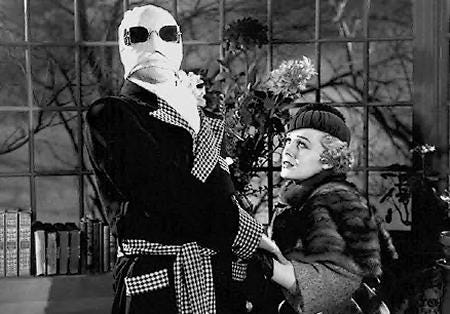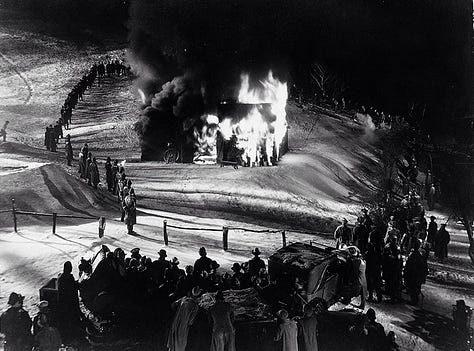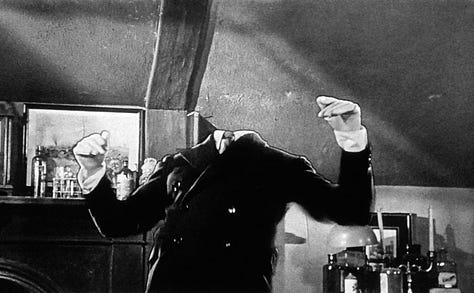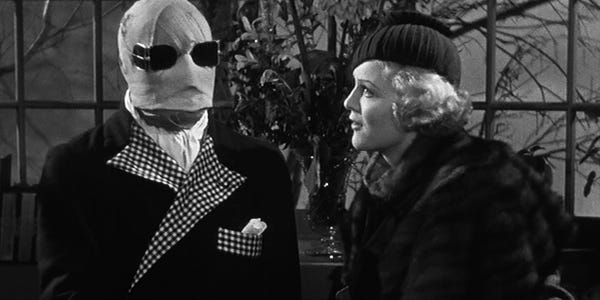This article was originally published on WordPress in December 2019. Revisions have been made to provide additional context and information on the subject.
Imagine there’s a person sitting right behind you, watching your every move, that you can’t see. You might not be able to prove it to a third party, or even to yourself. But you know that person is there, and that person knows that you know and is relishing every moment of your discomfort. They could do just about anything to you, and you would be powerless to stop them.
When H.G. Wells wrote The Invisible Man in 1897, he tapped into one of humanity’s deepest and most primal fears. Is it any surprise that horror and sci-fi filmmakers keep coming back to his work for inspiration? The novel has been adapted countless times for film, TV, radio, the stage and comics. Some creators will stick close to the original plot and setting, while others will take the basic premise — a scientist turns himself invisible, but doesn’t know how to change back — and run off in an entirely different direction with it. Universal themselves has tackled the concept a number of times, mostly recently in the excellent 2020 film that we’ll be covering later in this series.
For now, however, we’re talking about the studio’s first attempt at telling this story. Today we discuss 1933’s The Invisible Man, in all its fun and bizarre glory.
The Plot: Jack Griffin (Claude Rains) is a brilliant and ambitious chemist who has recently gone missing. No one can figure out where he went, since he left no message and destroyed all his research and notes before disappearing. But even if they could locate him, they couldn’t see him — Griffin has turned himself invisible through experimentation with a bleaching substance called monocane, and he hasn’t worked out the antidote yet. Using bandages, goggles and thick clothing to hide his condition, Griffin flees to the English village of Iping to continue his work. But when the villagers lose patience with his erratic behavior, he exposes his secret and begins terrorizing the town. Monocane, you see, has the side effect of driving you murderously insane, and Griffin is all hopped up on the stuff. Believing he can use his newfound power to conquer the world, Griffin sets out on a countrywide killing spree. News of his antics eventually reaches his old lab partner Dr. Kemp (William Harrigan), who becomes Griffin’s reluctant “accomplice.” It also attracts the attention of Griffin’s employer Dr. Cranley (Henry Travers) and Cranley’s daughter Flora (Gloria Stuart), who believes her love for Griffin can guide him back to sanity. Together with the London police, they search for a way to apprehend and cure Griffin. But how do you conduct a manhunt for an invisible man?
An adaptation of Wells’s novel was in development at Universal as early as 1931, just after the release of Dracula. Unlike Bram Stoker, however, H.G. Wells was still alive when this film was made. As a result, it’s far more faithful to its source material than Dracula or Frankenstein are. But that wasn’t the original plan.
Getting the right crew together proved a difficult task. Robert Florey, Cyril Gardner and German filmmaker E.A. Dupont were all attached to direct at some point. Potential screenwriters included John L. Balderston, Garrett Fort and Preston Sturges, who would later become famous for his screwball comedies. A dozen or so scripts were considered and rejected, ranging from a proto-superhero story set in Tsarist Russia to an alien invasion by invisible Martians, no doubt pulling from The War of the Worlds.
Being a tale of what happens when you dabble in unethical science, The Invisible Man is something of a successor to Frankenstein. So it should come as no surprise that Carl Laemmle finally gave the directing job to a familiar face, our old buddy James Whale. Whale promptly recruited his screenwriting partner, R.C. Sheriff, to throw away the outlandish drafts and write a script that was more true to the novel. Universal did purchase the rights to a Philip Wylie novel called The Murderer Invisible, wanting to incorporate some of its ideas and grisly setpieces into the film. But Whale would have none of that: he had great respect for Wells’s work, and he wanted to do the original story justice. The final script does diverge from the novel at some points—it adds a romance, kills off a character who originally survived and makes Griffin more sympathetic—but Wells found it good enough that he gave the film his blessing.
Next was the problem of finding a lead actor. Laemmle still insisted that the film be another Boris Karloff vehicle, but Whale believed the actor wasn’t right for the part. His choice was an unknown stage performer named Claude Rains, a friend that he’d worked with back in England. The studio was against it, citing Rains’s inexperience with film and a disastrous screen test at RKO. But when Karloff left Universal following a salary dispute, Whale finally got his way. And as fans of classic cinema will tell you, it’s a good thing he did. Lightning had struck twice for the studio already, and now a third unknown actor would be catapulted to stardom by a horror film.
The rest of the cast isn’t much to slouch at, either. Our female lead, Gloria Stuart, has a key role in a movie that everyone has seen—though you may not know it. Towards the end of a film/stage/television career lasting decades, she played the elderly version of Rose in James Cameron’s Titanic. Likewise, Henry Travers also prominently appears in another classic film: he is perhaps best known as the eccentric angel Clarence in It’s A Wonderful Life. Although William Harrigan never achieved that level of fame, he was still a respected Broadway and film actor at the time. Rounding out the supporting cast are faces we’ve already seen, like Dwight Frye, and faces who will reappear in the future, like British comedian Una O’Connor. The other behind-the-scenes names you should know for this one are John P. Fulton and John J. Mescall, who were responsible for the film’s visual effects. We’ll discuss those in more detail later.



If you’ve seen Frankenstein, then you’ll immediately recognize Whale’s fingerprints on Invisible Man. Bursts of dark, quirky humor run throughout the film, along with a quality I have termed “aggressive folksiness.” A lot of the film takes place in rural Britain, specifically the village of Iping in West Sussex where Griffin is holed up for the first act of the film. It’s a picturesque little town full of rambunctious, heavily accented characters who wouldn’t be out of place in a Wallace & Gromit short or a Monty Python skit. Chief among them is Una O’Connor’s loudmouthed innkeeper Jenny Hall, who reacts with hysterics to Griffin’s nonsense. It’s all meant to be rather silly and over-the-top.
See, The Invisible Man isn’t really a traditional horror film like the other movies we’ve watched so far. It’s more accurate to call it an early example of horror-comedy rather than straightforward horror. There are a lot of visual gags and slapstick sequences going on here, mainly when Griffin and the people chasing him have a direct confrontation. What sets Griffin apart from the previous monsters and antagonists in these movies is that there’s a clear liveliness and playfulness to his character. He’s not a straightforward killer like Dracula or Imhotep, not most of the time — his modus operandi is more about toying with people, freaking them out, delighting in their fear and paranoia. He’s a merry prankster, albeit one whose sadistic streak grows more and more pronounced.
The biggest part of what makes Griffin so fun to watch is the quality of Claude Rains’ performance. For the first twenty or so minutes, when Griffin is still keeping himself wrapped up, he’s subdued and even kind of imposing. But at the end of the first act, when Griffin embraces his invisibility and insanity, all bets are off. Suddenly there’s a tremendous amount of manic energy to the character, all of which is devoted to the fine art of scenery chewing. Earlier I’d said Henry Frankenstein was the gold standard for mad scientists, but it turns out he’s got nothing on Griffin here. For none can match Griffin’s many eloquent, over-the-top speeches about how he, a dude who is invisible but basically just an average human aside from that, is somehow going to become the evil overlord of the whole planet. With maybe one other person on his team. He is nothing if not optimistic. Rains commands your attention in this film, whether he’s physically onscreen or not. His unhinged nature—the yelling, the high-pitched laughing, all the skipping and prancing around—make him just as fun to watch as he is unsettling.
But don’t fool yourself into thinking that Griffin is all bark and no bite, for it turns out he is a master at creating mischief. I can think of no better demonstration of his trickster tendencies, and of the film’s comedic atmosphere, than the sequence about twenty minutes in where Griffin unleashes his wrath upon the residents of Iping. They know by now that he’s invisible, not that it matters much — part of the humor comes from several of the characters reacting to this revelation with mild annoyance as opposed to pants-wetting terror (“He’s invisible, that’s what’s the matter with him”). They’ve tried to keep him trapped upstairs (and clothed, therefore somewhat visible), but to no avail. Away he goes, running amok through the village and throwing a wrench into everybody’s morning. See, he’s not causing serious harm to any of them. He’s stealing bicycles, smacking people with brooms, grabbing people’s hats off their heads and throwing them into the river. It is not scary in the least, nor is it really meant to be scary. It is, instead, the essence of chaos in its purist form. It could almost be mistaken for a level of Untitled Goose Game, except with a loud, volatile nudist. Which isn’t that different from a goose, really.
This is a good place to briefly segue from discussing the plot and characters to discussing some more behind-the-scenes stuff. Specifically the visual effects, which are probably the biggest star here, if we’re being honest. The Invisible Man is an astounding technical achievement, especially for the time period. Most of them still look pretty great today, 86 years later. And while there are a few moments where I could tell how a certain trick or gag was pulled off — the bicycle Griffin steals being set to roll down a track, for example — there were even more moments where I found myself wondering “Wait, just how did they do that?”
Depicting Griffin when he’s completely invisible is simple, of course: Claude Rains does his lines via voiceover, and the camera films an empty space. What about when invisible Griffin is interacting with visible objects? With props hooked up to wires, you can simulate the effect of said props floating, flying around and otherwise reacting to Griffin’s touch, which is happening almost constantly in the film. But the real conundrum are the scenes where Griffin is partially visible: that is, where Rains is physically present in the shot but you still have to see that he’s invisible. How do you pull off something like that?
This is where John Fulton and John Mescall come in, along with a filmmaking technique called a traveling matte. In terms of filmmaking and photography, a matte is when you combine two different images — say, an actor and a background — into a single image. A traveling matte refers to instances when a moving object is contrasted with a background. It’s basically what filmmakers are doing whenever they use a greenscreen or bluescreen. Fulton discussed the process in an interview he gave in September 1934:
Most of these scenes involved other, normal characters, so we photographed those scenes in the normal manner, but without any trace of the invisible man. All of the action, of course, had to be carefully timed, as in any sort of double-exposure work. This negative was then developed in the normal manner.
Then the special-process work began. We used a completely black set—walled and floored with black velvet, to be as nearly non-reflective as possible. Our actor was garbed from head to foot in black velvet tights, with black gloves, and a black headpiece rather like a driver’s helmet. Over this, he wore whatever clothes might be required. This gave us a picture of the unsupported clothes moving around on a dead black field. From this negative, we made a print, and a duplicate negative which we intensified to serve as mattes for printing. Then, with an ordinary printer, we proceeded to make our composite: First we printed from the positive of the background and the normal action, using the intensified, negative matte to mask off the area where our invisible man’s clothing was to move. Then we printed again, using the positive matte to shield the already printed area, and printed in the moving clothes from our “trick” negative. This printing operation made our duplicate, composite negative to be used in printing the final master prints of the picture.
(Weaver 82)
The process may have been long and arduous for everybody involved, but their hard work paid off. The special effects in this film are still mesmerizing today, almost ninety years later.
Now to return to the plot, since we’ve only covered the first act of the film so far. Up to this point, The Invisible Man has been more comedy than horror. The creepy moments have been upstaged by slapstick and over-the-top performances. But once Griffin escapes from Iping and tracks down Kemp, the horrific elements of the narrative begin to hold greater sway. Through the latter sections of the film, particularly Kemp’s storyline, we see the danger and paranoia that an antagonist like Griffin could actually cause.
If Griffin is the character that’s living in a dark slapstick comedy, then Kemp is the one who’s trapped in a genuine horror story. His missing lab partner breaks into his house late at night, invisible and mentally unstable, and proceeds to hold him prisoner. He’s forced to give aid and shelter to this dangerous person so he doesn’t get murdered himself, and it’s made quite clear to him that if he even thinks about betraying his captor, he’s a dead man.
What the film actually does with Kemp is surprising. If you’re familiar with these older horror films and the tropes most common to them, then Kemp initially appears to occupy a specific role within the narrative. I like to call that role “the backup love interest.” A more in-depth discussion of it will be saved for the article two movies from now, when we’ll get to see a true example of that archetype in action. But for now, the important thing is that when Kemp first shows up, it seems like he’s only in the movie so Griffin’s girlfriend Flora can end up with somebody after her lover inevitably dies.
The Invisible Man screws with these expectations in two significant ways. The first is that Kemp’s not an especially sympathetic character. Before learning what’s happened, he uses his lab partner’s disappearance as an excuse to sniff around Flora, who calls him out on what he’s doing. The second twist in Kemp’s narrative is that his story completely changes once Griffin tracks him down. It becomes a story about these two men facing off in a much more direct way and the twisted relationship they have with each other. Some pretty good drama and creepiness comes out of Kemp’s efforts to try and warn someone about the dangerous criminal threatening him while dealing with the constant possibility that said criminal could be watching him without his knowledge. It cuts right to the heart of what makes The Invisible Man as a concept so frightening.
Eventually, of course, Kemp does manage to help the authorities lay a trap for Griffin. Griffin escapes, but not before promising Kemp that he will murder him at 10 PM the next night. The police enact an elaborate scheme to get him safely out of the city, making it look like he’s under watch at a police station when he’s actually escaping to the countryside by himself. When the appointed hour rolls around, Kemp is driving on an empty road, thinking he’s safe…and then Griffin speaks up.
“I think this will do nicely, Kemp…I came with you to keep my promise.”
What follows is a genuinely shocking murder scene in which Griffin restrains Kemp, puts him back in the car and then shoves the car over a cliff. The sounds of Kemp screaming and Griffin cackling play over each other to create a cacophony of noise crashes on several rocks and bursts into flames. It’s made even more eerie by the way Griffin tells Kemp what’s going to happen to him just before doing the deed.
“Just sit where you are. I’ll get out and take the handbrake off and give you a little shove to help you on. You’ll run gently down and through the railings, then you’ll have a big thrill for a hundred yards or so ‘til you hit a boulder. Then you’ll do a somersault and probably break your arms. Then a grand finish up with a broken neck.”
An element that I think sets The Invisible Man apart from its predecessors is the way it depicts and uses violence. Violent moments have appeared in the previous Universal Horror films, of course. But many of the moments that would be graphic are not dwelled upon: the camera will cut away or fade to black at the right moment, or we’ll only see the aftermath of some violent act. But the violence here is quick, intense and succeeds in looking/feeling brutal. Early on, for example, there’s a scene where a man is thrown down some stairs. The way it’s shot and staged shows you the height at which he falls from, how rough his landing is, how horrified his friends are when they witness this. It’s a wince-inducing moment, even though nothing overtly graphic happens. The murder of Kemp looks like it could have been filmed by throwing an actual car over a cliff, and you shudder at the thought of being in that scenario when you watch it.
When I first did a review of this film, my main criticism was that the horror and comedy elements didn’t quite gel with each other in the latter half of the story. It felt disorienting to see Griffin go from outlandish slapstick in one scene to cold-blooded murder in the very next. But upon subsequent rewatches, I realizes: that’s the point. Griffin is frightening not just because he’s invisible, but because he’s unpredictable. One moment he can be skipping down a country road singing to the tune of a nursery rhyme, and then the next time we see him, he can derail a train and kill a hundred people in an instant. He’s got a higher onscreen body count than all the previous Universal monsters combined, and there’s no telling when he will do something to make that number go up.
But the true genius of this film lies in a simple fact: despite all that Griffin does, you still like him. Why? He’s great fun to watch, it’s true, but there’s also a more poignant element at work. The film does a wonderful job of showing you that Griffin’s first victim in his reign of terror was, in a way, himself. He chose to experiment with the monocane, but he genuinely had no way of knowing it would cause his mind to deteriorate. He is already in the throes of insanity when we first meet him, but as the story proceeds, we learn that he wasn’t always like this. And when he briefly reunites with Flora in the latter half of the film, we finally get to see him regain a little bit of his sanity. He’s gentle with her and confesses that all he’s truly wanted is to make her proud and become wealthy enough to marry her. The contrast from his prior mania makes his slide back into madness just a few moments later all the more disturbing. The audience may not want him to get away with his crimes, but they do want him to at least get better.
Of course, this isn’t that kind of story. Griffin only returns to his right mind in the final scene of the film, when he lies bleeding out after a fatal gunshot wound. He seeks comfort and forgiveness from Flora just before he dies, saying that he never meant for all these terrible things to happen. And only after his death does he finally get the thing he’s been searching for—his body becomes visible again, from the skeleton up to the skin. Like Frankenstein’s Monster, he is ultimately a tragic figure whose tale has a bitter yet inevitable conclusion. The empathy he generates is, I think, what pushes the film as a whole to cinematic immortality.
Though it may not be as creepy as Dracula or pack a serious emotional punch like Frankenstein, The Invisible Man is an essential piece of Universal’s horror canon. The film’s groundbreaking visual effects are often considered its true star, and while they are valuable, they’re only a single part of what makes the final product great. James Whale lets himself loose on the source material; together with screenwriter R.C. Sheriff, he creates a thriller brimming with paranoia and dark comedy in equal measure. In his first film role, Claude Rains instantly cements his place in cinematic history with an inspired performance as the off-putting yet pitiable title character. Not bad for a guy whose face only appears onscreen in the final shot of the film.
Final Rating: 4 Stars
As Universal approached the middle of the 1930s, they had four successful horror films under their belt and several characters and actors who were quickly becoming icons. It was time to forge new territory — not by finding another novel to adapt, but by building up from the foundations they’d created.
UP NEXT: Bride of Frankenstein (1935)
Works Cited and Further Reading
Landis, John. Monsters in the Movies: 100 Years of Cinematic Nightmares. Reprint, DK Publishing, 2016.
Mallory, Michael. Universal Studios Monsters: A Legacy of Horror. Universe Publishing, 2021.
Soister, John. Of Gods and Monsters: A Critical Guide to Universal Studios’ Science Fiction, Horror and Mystery Films, 1929-1939. 2nd ed., McFarland and Company, 2005.
Weaver, Tom, Brunas, Michael, & Brunas, John. Universal Horrors: The Studio’s Classic Films, 1931–1946 (2nd ed.). McFarland & Company, Inc. 2007.





